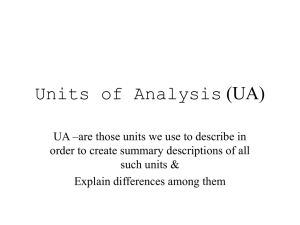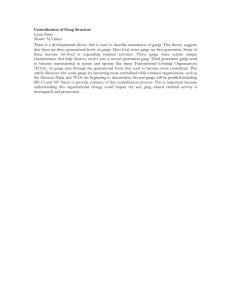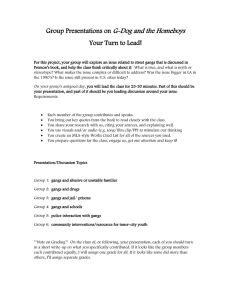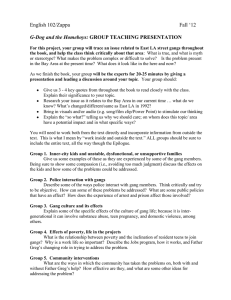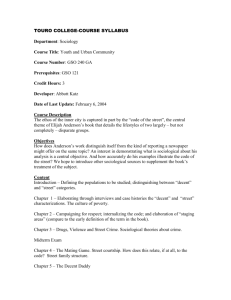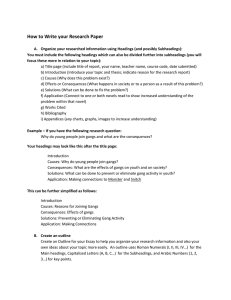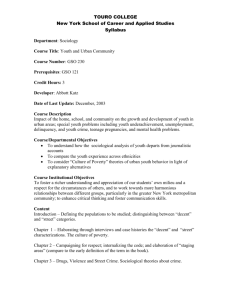GANGS, HOOLIGANS, AND ANARCHISTS—THE VANGUARD OF NETWAR IN THE STREETS
advertisement
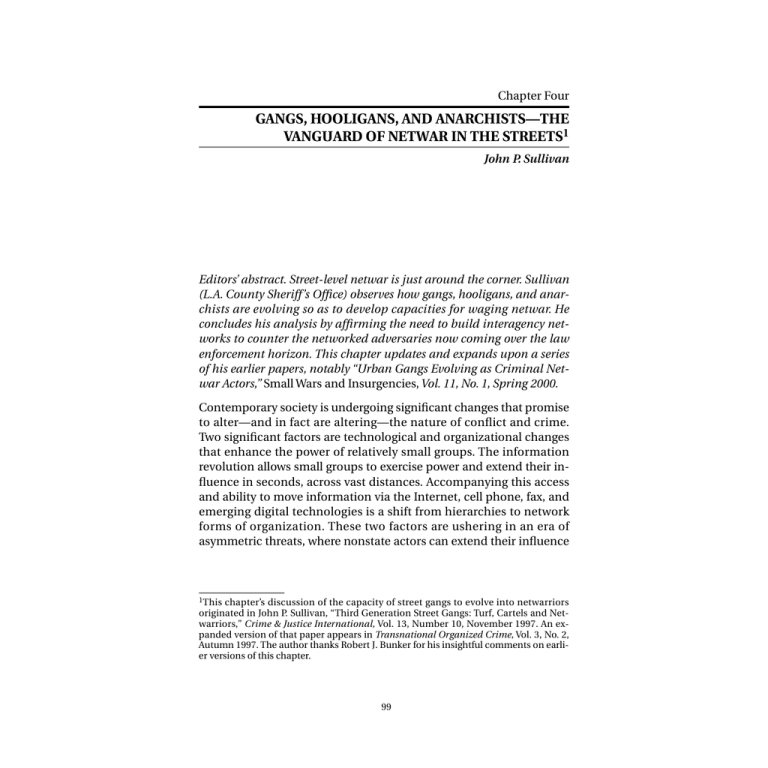
Chapter Four GANGS, HOOLIGANS, AND ANARCHISTS—THE VANGUARD OF NETWAR IN THE STREETS1 John P. Sullivan Editors’ abstract. Street-level netwar is just around the corner. Sullivan (L.A. County Sheriff ’s Office) observes how gangs, hooligans, and anarchists are evolving so as to develop capacities for waging netwar. He concludes his analysis by affirming the need to build interagency networks to counter the networked adversaries now coming over the law enforcement horizon. This chapter updates and expands upon a series of his earlier papers, notably “Urban Gangs Evolving as Criminal Netwar Actors,” Small Wars and Insurgencies, Vol. 11, No. 1, Spring 2000. Contemporary society is undergoing significant changes that promise to alter—and in fact are altering—the nature of conflict and crime. Two significant factors are technological and organizational changes that enhance the power of relatively small groups. The information revolution allows small groups to exercise power and extend their influence in seconds, across vast distances. Accompanying this access and ability to move information via the Internet, cell phone, fax, and emerging digital technologies is a shift from hierarchies to network forms of organization. These two factors are ushering in an era of asymmetric threats, where nonstate actors can extend their influence 1This chapter’s discussion of the capacity of street gangs to evolve into netwarriors originated in John P. Sullivan, “Third Generation Street Gangs: Turf, Cartels and Netwarriors,” Crime & Justice International, Vol. 13, Number 10, November 1997. An expanded version of that paper appears in Transnational Organized Crime, Vol. 3, No. 2, Autumn 1997. The author thanks Robert J. Bunker for his insightful comments on earlier versions of this chapter. 99 100 Networks and Netwars: The Future of Terror, Crime, and Militancy and challenge states and their institutions to gain social, political, or economic influence. This chapter examines the potential for certain small groups—in particular, urban criminal gangs—to embrace network forms of organization and doctrine, and to utilize advanced information technology to wage netwar. This potential lies on the blurry border between crime and warfare and threatens to change the faces of gangsterism and terrorism. It challenges state institutions such as the police, the military, courts, and political leadership to develop responses that protect the public and preserve civil order. The mutation of traditional urban gangs into a new generation that is organized and operates in the manner of many highly networked triads, cartels, and terrorists is highlighted. The chapter shows that politicization, internationalization, and sophistication are three factors that influence gang organization and help explain how a net-based threat can mature. Finally, the example of Black Bloc anarchists, who utilize sophisticated networked tactics and violence to stimulate political action, is reviewed to illustrate the difficulties police encounter when facing networked adversaries. THREE GENERATIONS OF URBAN GANGS: THE EVOLUTION TO NETWAR The information revolution is changing the nature of conflict and crime. Organizational changes benefit from these new technologies. As described by RAND analysts John Arquilla and David Ronfeldt, networks can prevail over hierarchies in this postmodern battlespace: “Power is migrating to small, nonstate actors who can organize into sprawling networks more readily than can traditionally hierarchical nation-state actors.”2 This conforms to the prediction made by eminent military historian Martin van Creveld, In the future war, war will not be waged by armies but by groups whom today we call terrorists, guerrillas, bandits and robbers, but 2 John Arquilla and David Ronfeldt, “A New Epoch—and Spectrum—of Conflict,” in John Arquilla and David Ronfeldt, eds., In Athena’s Camp: Preparing for Conflict in the Information Age, Santa Monica, Calif.: RAND, 1997, p. 5. Gangs, Hooligans, and Anarchists—The Vanguard of Netwar in the Streets 101 who will undoubtedly hit on more formal titles to describe themselves.3 Thus, netwar may result, in some cases, in a distinct and perhaps refined form of what we generally refer to as terrorism. In netwar, alliances between and among state and nonstate actors can fuel conflict. Combinations of “internetted” transnational criminal organizations (TCOs), triads, cartels, cults, terrorists, gangs, and other entities replace their more state-oriented predecessors. Again, Arquilla and Ronfeldt are instructive with their view that “netwar” [is] an emerging mode of conflict (and crime) at societal levels, involving measures short of war, in which the protagonists use—indeed, depend upon using—network forms of organization, doctrine, strategy and communication.4 In the past, loosely organized violent criminal entities like gangs were discounted as serious terrorist threats and excluded from discussions of classic terrorism. But recognition of new technological and organizational factors shows that such entities are especially well-suited to exploit new forms of conflict. Arquilla and Ronfeldt observe that netwar is about Hamas more than the PLO, Mexico’s Zapatistas more than Cuba’s Fidelistas, the Christian Identity Movement more than the Ku Klux Klan, the Asian Triads more than the Sicilian Mafia, and Chicago’s Gangsta Disciples more than the Al Capone Gang.5 With a focus on gangs that especially concern urban police agencies, this chapter explores the convergence of some of these groups on the road to netwar. Gangs operating in urban areas have gone through three generational changes—from traditional turf gangs, to marketoriented drug gangs, to a new generation that may mix political and mercenary elements. Particularly important for this evolution are 3Martin van Creveld, The Transformation of War, 4John New York: The Free Press, 1991. Arquilla and David Ronfeldt, “The Advent of Netwar,” in John Arquilla and David Ronfeldt, eds., In Athena’s Camp: Preparing for Conflict in the Information Age, Santa Monica, Calif.: RAND, 1997, p. 227. 5Ibid. 102 Networks and Netwars: The Future of Terror, Crime, and Militancy trends in the degree of politicization, internationalization, and sophistication of a gang. Politicization refers to the scope of political activity embraced by the gang. For example, most gangs are largely criminal enterprises, but some have begun to adopt varying degrees of political activity. At the low end, this activity may include dominating neighborhood life and creating virtual “lawless zones,” application of street taxes, or taxes on other criminal actors. Gangs with more sophisticated political attributes typically co-opt police and government officials to limit interference with their activities. At the high end, some gangs have active political agendas, using the political process to further their ends and destabilize governments. Internationalization refers to the spatial or geographic reach of the gang. Most gangs are extremely local in nature, generally spanning several blocks of turf. Other gangs operate as confederacies of smaller “cliques,” working across entire metropolitan regions and nationally across state boundaries. At the high end, some gangs are crossborder, transnational, or even international in scope with outposts in foreign cities. Sophistication addresses the nature of gang tactics and strategies, the use of weapons and technology, and organizational complexity of the gang. Gangs can demonstrate their sophistication in one or more of these areas. For example, a gang could use sophisticated infantry tactics to conduct ambushes, utilize networked organizational forms, or utilize information technology. The simplest indicator of sophistication is the ability to seek and forge alliances or networks of smaller gangs. This potential is often underestimated, since networks (such as the umbrella “Crip,” “Blood,” “Folk,” and “People” groupings) do not generally adopt the hierarchical forms of traditional organized criminal entities familiar to police. It is important to recognize that networks are not less sophisticated than hierarchies, just different. To a large extent, the diffusion of information technologies and/or networked organizational forms among urban gangs remains largely unstudied. Each generation, as described below, has different characteristics, which affect the potential for what gangs may do on their own, when Gangs, Hooligans, and Anarchists—The Vanguard of Netwar in the Streets 103 drawing inspiration from major criminal and terrorist organizations, or even when linking up with these organizations. The characteristics of these three gang generations are summarized in Figure 4.1. The attributes of gangs, hooligans, and anarchists in terms of the indicators of politicization, internationalization and sophistication are illustrated in Table 4.1. The First Generation—From Traditional Street Gang to Soccer Hooligans Traditional street gangs operate at the low end of extreme societal violence. Primarily turf-oriented, they are characterized by loose leadership with a focus on loyalty and turf protection in their immediate neighborhoods. Members of such gangs engage in opportunistic criminal activity, including rivalry for drug sales as lone individuals and as a gang competing with other gangs. These first-generation (turf ) gangs are limited in political scope, are localized (often by city blocks), and are not highly sophisticated. While traditional street gang activity does not constitute terrorism in the classic sense, it acts as a conflict generator that may provide the necessary foundation for some groups to evolve into complex internetted criminal entities, or even netwarriors. Examples of traditional RAND MR1382-4.1 Limited Politicization Evolved Local Internationalization Global 1st Generation Turf gang Turf protection Proto-netwarrior 2nd Generation Drug gang Market protection Emerging netwarrior 3rd Generation Mercenary gang Power/financial acquisition Netwarrior Less sophisticated Sophistication More sophisticated MR1382 fig 4.1 Figure 4.1—Characteristics of Street Gang Generations 104 Networks and Netwars: The Future of Terror, Crime, and Militancy Table 4.1 Netwar Potential of Gangs, Hooligans, and Anarchists by Indicator Gang or Group Crips/Bloods Politicization Low Internationalization Medium Sophistication Low-Medium People/Folk Low Medium Low-Medium 18th Streeta Low-Medium High Medium-High Mara Salvatruchaa Low High Medium Football Firmsb Low Medium-High Medium-High Gangster Disciplesa High Medium Medium Black P Stone Nation Medium Medium Medium Vice Lordsa High Medium Medium Calle Treintaa Medium-High High Medium Pagada High Low-Medium Medium Hard Livingsa High Low Medium Anarchists/Black Bloca High High Medium-High aDisplays emerging third-generation gang characteristics/netwarrior potential. bFor example, Inter City Firm, Service Crew, Ultra Sur, Tiger Commandos, etc. gangs include the Chicago-based “Folk” and “People” Nations and Los Angeles–based “Crips,” “Bloods,” and their ubiquitous Hispanic counterparts including the notorious “18th Street” gang. Such street gangs, while violent, have been viewed as outside of the realm of true terrorism because of their lack of formal organization. In fact, one noted Los Angeles gang investigator, Wesley McBride, describes traditional gang activity as “disorganized crime in action.”6 Yet informal, network-like organization is one of the factors that may make netwar more difficult to combat than classic terrorism. Analyst Robert J. Bunker sees this as one of the factors that may contribute to the rise of nonstate “soldiers.” Other factors contributing to this emergence include failed communities with disintegrating social structure and increased sophistication. In Bunker’s view, terrorism is an insidious form of warfare based on social rather than political con6This characterization is chronicled in Robert J. Bunker, “Street Gangs—Future Paramilitary Groups,” The Police Chief, June 1996. Gangs, Hooligans, and Anarchists—The Vanguard of Netwar in the Streets 105 siderations.7 He sees “armed nonstate actors intent on legitimizing forms of behavior that current societies consider to be criminal or morally corrupt” as a major security threat, with networked threats potentially organizing into “new warmaking entities, the smallest of which will be subnational groups, such as armed bands, private armies, and local crime organizations.”8 In that context, a web of dispersed, interconnected “nodes” gains relative advantage, since doctrine or common purpose is more important than hierarchical leadership. This view is similar to the observations of Arquilla and Ronfeldt regarding the emergence of netwar where societal-level conflicts are waged through internetted modes of communication, leading to the enhanced standing of nonstate actors. While street gangs may be in a position to exploit changes in social organization, the majority of street gangs remain firmly in the first (turf focus) or second (nascent organized crime groups with a drug focus) generation. Gangs that span the first and second generations include some Crip and Blood sets, as well as a few Hispanic gangs such as 18th Street. These gangs tactically employ limited quasi-terrorism to support their activities. Like other organized crime groups, such street gangs use criminal terror, targeting each other, or interfering agencies, to sustain spatial or economic spheres of influence—“turf” or “markets.” Finally, some gangs are becoming increasingly mobile, gaining in sophistication, developing links with organized crime entities, and maintaining caches of weapons financed by the large sums of money obtained from multistate or cross-border narcotics distribution networks.9 7See Robert J. Bunker, “The Terrorist: Soldier of the Future?” Special Warfare, Vol. 10, No. 1, Winter 1998, “Epochal Change: War over Social and Political Organization,” Parameters, Vol. 27, No. 2, Summer 1997, and “Street Gangs—Future Paramilitary Groups,” The Police Chief, June 1996, for a discussion of the potential emergence of the nonstate (criminal) soldier and related threats to security. 8Robert J. Bunker, “Epochal Change: War over Social and Political Organization,” Parameters, Vol. 27, No. 2, Summer 1997. 9The 20,000 member, multiethnic Los Angeles drug gang 18th Street is a pertinent example. See Rich Connell and Robert Lopez, “An Inside Look at 18th St.’s Menace,” Los Angeles Times, November 17, 1996, for an in depth review of the gang’s operations. A discussion of 18th Street’s cross-border activities and links with Eme (the Mexican Mafia) is found in Rich Connell and Robert Lopez, “Gang Finds Safe Haven and Base for Operations in Tijuana,” Los Angeles Times, September 19, 1996. 106 Networks and Netwars: The Future of Terror, Crime, and Militancy An interesting variation on the traditional turf gang is the rise of soccer hooligans in Europe; for them, the important turf is not a neighborhood per se, but more a “virtual turf,” as represented by their favorite local or national soccer team. Football hooligans are largely a European gang form, and soccer or football violence is a major social ill throughout Great Britain and the rest of Europe. Roving bands of thugs looking for street battles mar football games throughout the continent, injuring participants, police, and bystanders alike. These bands, known as “firms,” differ from normal football supporters, since violence for violence’s sake takes precedence over team success. Firms travel from stadium to stadium via ferry and train to engage their adversaries. They act like ethnonationalist marauders. British firms include the infamous “super-hooligan” armies, such as the Inter City Firm from West Ham and the Service Crew from Leeds. Other notable firms include Chelsea’s Headhunters and Milwall’s Bushwhackers. These firms generally have about 20 hardcore members, with total membership into the hundreds. British police divide football supporters into three categories. Category A involves typical fans; Category B consists of hooligans who occasionally embrace violence; and Category C is reserved for hardcore violent hooligans. All can engage in violence under certain circumstances. British police estimate that there are approximately 600 hardcore (or Category C) hooligans in Great Britain. Up to 250–300 associates who participate in violence when under the influence of alcohol (Category B) supplement the violence orchestrated by the hardcore Category C nucleus. Category A members, the more typical football supporters, provide the outer fringe of the phenomena. Continental firms include Ultra Sur, which supports Real Madrid; Milan’s Tiger Commandos and the Red & Black Brigade; as well as Barcelona’s Boixos Nois (Crazy Boys). What appears to have originated as spontaneous violence is now carefully coordinated and orchestrated. Hooligans are integrating network and hierarchical command and control to enhance their combat effectiveness with technology. Firms of opposing hooligans now use wireless technology and the Internet (email, etc.) for both marshalling their own combatants and challenging their opponents. For example, Milwall’s Bushwackers are believed to have used Inter- Gangs, Hooligans, and Anarchists—The Vanguard of Netwar in the Streets 107 net tools (an interactive web site and real-time messaging) to organize and coordinate the violent activities of hooligans traveling to a match in Cardiff, where 14 people were hurt and 6 arrested. Messages had been posted both during and throughout the week prior to the game, demonstrating the dangers of organized gangs of hooligans using the Internet. Police and the National Criminal Intelligence Service (NCIS) in the U.K. believe the Cardiff melee confirms their fears that organized soccer firms are turning to modern technology, including computers and mobile phones, to avoid police intervention.10 Wireless technology allows the firms to coordinate their battle plans and issue tactical operations to precision-guide both pulsing and swarming attacks across Europe’s borders.11 Second-Generation Street Gangs—The Influence of Organized Crime Entrepreneurial, drug-centered street gangs occupy the second generation. Interested in market protection, these gangs view drugs as a business. They use violence to control their competition and assume a market rather than a turf orientation. With a broader, marketfocused political agenda, these gangs operate across a greater geographic (sometimes multistate) area, tend to have centralized leadership, and conduct more-sophisticated operations, particularly for market protection. Second-generation gangs, like the first, are firmly established criminal threats.12 But while first-generation gangs operate much like clans, these second-generation types operate more like professional businesses. Drug selling becomes a necessity rather than an optional individual activity. Second-generation street gangs utilize violence in a manner similar to that of drug cartels, narcoterrorists, and other organized crime groups. These gangs’ activities—partly because of their focus on mar- 10 “Football hooligans use Internet for rampage,” ITN Online, August 8, 1999, www.itn.co.uk/Britian/brit19990808/080801.htm. 11Tim Reid and Chris Boffey, “Behind the Thugs, ‘Generals’ Call Shots,” Sydney Morning Herald, June 22, 1998. 12See Malcolm W. Klein, The American Street Gang, New York: Oxford University Press, 1995. The distinction between street and drug gangs is found in Table 4-4, p. 132. 108 Networks and Netwars: The Future of Terror, Crime, and Militancy ket protection—fall into the center of the range of politicization, internationalization, and sophistication. Market protection may necessitate a step toward the use of violence as a political means, and these groups can be expected to exploit both violence and new forms of technology to extend their place in the criminal marketplace. Crime and violence often blur when criminal enterprises seek to incapacitate enforcement efforts by the state, its police, and security forces. The use of violence as political interference has traditionally been a phenomenon of failed states, but a similar phenomenon occurs when street gangs exploit “failed communities” and dominate community life. As this exploitation occurs in the United States (particularly in neglected inner cities), it reflects what has already occurred in other countries where organized crime has taken hold in embattled “lawless zones.” Particularly worrisome is narcoterrorism, which emerged as a result of collaboration between terrorist or guerrilla insurgents and drug cartels, and which involves the use of terror in support of cartel business. While the Andean cocaine trade and Colombian cartels are notorious for the use of narcoterrorism, recent instances of such terror are also evident in Mexico. The extensive terror and disruption practiced by narcotics producing and trafficking cartels can incapacitate government enforcement efforts, paralyze the judiciary, fuel corruption, and destabilize local communities and nation states alike. Colombian experiences include bombings of public facilities, banks, commercial facilities, and aircraft and assassinations of supreme court justices, cabinet-level officials, magistrates, police officers, and journalists. Mexican cartels have targeted police officials in both Mexico and U.S. border states as well as journalists. Needless to say, cartels in both nations also target rival cartels. Colombia’s Medellín and Cali cartels and, more recently, the ArellanoFélix and other cartels in Mexico have employed extreme violence to further economic—and de facto emerging political—goals. Colombian narcotraficantes have recruited members from guerrilla insurgencies, such as FARC (Fuerzas Armadas Revolucionarias de Colombia), ELN (Ejército de Liberación Nacional) and M-19 (April 19th Movement); utilized guerrillas to conduct mercenary operations when their terrorist capability eroded; and solicited terrorist specialists, Gangs, Hooligans, and Anarchists—The Vanguard of Netwar in the Streets 109 perhaps including the ETA (Basque Fatherland and Liberty), for technical assistance. Colombian cartels also on occasion target insurgent groups, such as M-19 and FARC themselves, while Peru’s Sendero Luminoso (Shining Path) has used the drug trade to support its insurgency. Such examples illustrate the complex intertwining of politics, crime, and terrorism. The interaction between cartels and terrorists poses a significant threat to legitimate governments. In this mix, drugs finance terrorists, while terrorists protect drug operations. Building upon relationships initially forged as marriages of convenience, the armed militias supporting contemporary cartels are equipped with modern weapons and seek to disrupt and preempt rather than merely react to government enforcement efforts. For example, FARC and ELN, with an estimated combined strength of 25,000 members, routinely disrupt oil pipelines and carry out wide-ranging acts of urban terrorism to undermine public support for the government.13 The links between terrorist and organized crime (including drug traffickers) extends beyond the Andean drug states to form an integral node in the global network of organized criminal entities. Drug cartels are not the only organized crime groups to engage in terrorist-like violence (or quasi-terrorism) to support their goals. Other nonstate actors—including millennialist cults and such transnational criminal organizations as the Asian Triads and other criminal enterprises—are also players. The Sicilian Mafia, the Russian mafiyas, and recently the Chinese 14K Triad have embraced bombings and high-order violence to influence government activity and achieve their goals. The Sicilian Mafia14 has links with Colombian cartels, La Cosa Nostra (the American Mafia), and many Asian organized crime groups. Its tactics have included assassination, bombings, and kidnapping. Targets have included the police (including senior officers of the Carabinieri), magistrates, justices, and their families. Public 13John G. Roos, “The Enemy Next Door: Good Reasons to Hammer South America’s Drug Cartels,” Armed Forces Journal International, March 2000. p. 40. 14An early journalistic account of the evolution and power of the Sicilian Mafia’s networking is found in Claire Sterling, Octopus: The Long Reach of the International Sicilian Mafia, New York: W.W. Norton & Company, 1990. 110 Networks and Netwars: The Future of Terror, Crime, and Militancy buildings, such as police stations, railway stations, restaurants, courts, and department stores, have also been attacked. The Sicilian Mafia provides many useful insights into networking and politicization. The Sicilian Mafia (like the Colombian and Mexican cartels and at times the Russian mafiyas) is highly politicized, at times even capturing state institutions. As described by the Italian Parliamentary Anti-Mafia Commission, the Sicilian Mafia is a genuine criminal counter-power, capable of imposing its will on legitimate states. Of undermining institutions and forces of law and order, of upsetting delicate economic and financial equilibrium and destroying democratic life.15 Indeed, Manuel Castells sees the Sicilian Mafia as part of a “global, diversified network, that permeates boundaries and links up ventures of all sorts.”16 This network, which allows traditional criminal entities to escape the controls of a given state at a given time, includes the American Mafia, the constellation of Russian mafiyas, Colombian and Mexican cartels, Nigerian criminal networks, Chinese triads, and the Japanese Yakuza (itself a network of constituent entities including the Yamagachi-gumi, with 26,000 members in 944 networked gangs; the Inagawa-kai; and the Sumiyoshi-kai). Castells observes that the Sicilian Mafia, by linking with this diffuse global network, remains one of the most powerful criminal networks in the world. Drawing from its deep penetration of the Italian State, particularly its political influence over the Christian Democratic Party, the Mafia was able to exert its presence throughout Italy’s political, business, and financial infrastructure. When the state sought to reassert its autonomy, the Mafia reacted with unprecedented violence and brutality. When the state prevailed in its efforts to limit the Mafia’s control of government institutions, the Mafia strengthened its international linkages and enhanced its networking, providing flexibility 15“Report of the Anti-Mafia Commission of the Italian Parliament to the United Nations Assembly,” March 20, 1990, as cited in Claire Sterling, Thieves World: The Threat of the New Global Network of Organized Crime, New York: Simon & Schuster, 1994, p. 66. 16Manuel Castells, “The Perverse Connection: the Global Criminal Economy” (Chapter 3) in Manuel Castells, ed., End of Millennium, Oxford, U.K.: Blackwell Publishers, 1998. Gangs, Hooligans, and Anarchists—The Vanguard of Netwar in the Streets 111 and versatility to the organization. As a result, the Sicilian Mafia and its allied organizations embrace networking both internally in their own organizations and externally with other criminal organizations as a way to counter state interference. Thus flexible networking among local turfs and strategic alliances with other traditional criminal enterprises allow the Sicilian Mafia, like its partners, to achieve global reach.17 Russian organized crime groups, loosely known as the mafiyas, have utilized similar approaches, adding trafficking in weapons of mass destruction and local political dominance in parts of the former Soviet Union to their repertoire. Russian mafiyas operate in 60–65 countries and include about 6,000 separate groups, 200 of which operate in the United States. Within this series of loose, dynamic networks of semiautonomous entrepreneurs are a collection of gangs, crews, and individuals operating in a dozen major networks in up to 20 American cities. With a flexible and diffuse structure, these mafiya nodes are responsive to new threats and opportunities and are virtually impossible to decapitate.18 These groups are flexible and often seek alliances with a variety of entities, including former KGB operatives and other criminal enterprises, including partnerships or service provision to relatively low-level gangs. A good example of a contemporary TCO, these mafiyas are often better organized and financed than the police. Their activities cross so many borders that intergovernmental coordination is awkward. In brief, they are less constrained by bureaucracy, have more money, and have access to the best technology.19 Triads are also players in the quasi-terrorist game. The Hong Kong– based 14K Triad has conducted an extended terror campaign in Macao.20 Utilizing petrol bombs, attacks on police and journalists 17Ibid. 18 Mark Galeotti, “Russia’s Criminals Go Global, Jane’s Intelligence Review, March 2, 2000, http://jir.janes.com/sample/jir0659.html. 19Richard C. Paddock, “A New Breed of Gangster Is Globalizing Russian Crime,” Los An- geles Times, September 23, 1998. 20Niall Fraser and Adam Lee, “Bombers ‘Targeting’ Casino Watchdogs,” South China Morning Post, October 24, 1997. 112 Networks and Netwars: The Future of Terror, Crime, and Militancy with secondary devices,21 and attacks against infrastructure and public places, this campaign illustrates the use of terror as a political tool by a criminal enterprise. The 14K campaign exists within the vacuum of power resulting from the transition from Portuguese to Chinese rule. This transition has yielded an intertriad war, where organized crime groups including Hong Kong triads, mainland Chinese gangs from Guangdong Province, and corrupt security officials interact in an ever shifting web of alliances, business deals, and violence. Within this framework, the 14K campaign seeks to influence the police, government agencies, casino watchdogs, and other criminal groups. These trends in transnational crime—and criminal netwar—abroad have, to some extent, worked their way into the United States. Further penetration must be guarded against, especially to prevent their linking up with American gangs. A danger is that gangs like the Bloods, Crips, or Gangster Disciples will be drawn increasingly into serving as wholesale trafficking and distribution networks for foreign cartels. Third-Generation Gangs: Social, Political, and Mercenary Objectives The overwhelming majority of street gangs are first or second generation. However, a small number of gangs in the United States and South Africa are also moving into the next generation. A third-generation gang is a mercenary-type entity focused on power and financial acquisition. These criminal netwar actors have significant political aims, aspire to operate at the global end of the spectrum, and are more sophisticated than first- and second-generation gangs. Currently, no gang is fully within the third generation, but some are moving swiftly along the spectra of politicization, internationalization, and sophistication. These gangs can be expected to utilize terrorism (including for hire) to advance their influence and can be expected to challenge the institutions of the nation state. 21In September 1998, 14K bombers conducted one bombing to attract police and the media and shortly afterward set off a second device injuring four police and ten journalists. See Steve Macko, “Macau Mobsters Sending a Bloody Warning to Police?” ERRI Emergency Services Report, Vol. 2-251, September 8, 1998. Gangs, Hooligans, and Anarchists—The Vanguard of Netwar in the Streets 113 For the most part, these gangs are mercenary in orientation; however, in some cases they share some political and social objectives. Examples of third-generation evolution among gangs in Chicago, San Diego, Los Angeles, and Cape Town, South Africa are provided in the following discussion. The potential for third-generation street gangs first emerged in Chicago. It is home to approximately 125 gangs, including some of the most complex, well-disciplined gangs in the nation. A few demonstrate the sophistication and political savvy of third-generation evolution. These gangs not only create and sustain alliances, but act as paramilitary groups embracing terrorism or terrorism for hire. The “El Rukn” gang (currently known as the “Black P Stone Nation”), which sought to carry out terrorism for hire on behalf of Libya is an early example. Members of the gang once traveled to Libya, trained for terrorist operations in abandoned buildings, and sought to arm themselves with rocket-propelled grenades. Under the leadership of Jeff Fort, the gang diverted economic development funds into criminal activity and later endeavored to conduct terrorist operations for hire. If successful, the gang might have blown up airplanes and buildings on behalf of Moammar Qaddafi, and obtained payments in the millions of dollars. Fort is currently in prison for a 1986 mercenary conspiracy. An example of high-level violence among Chicago gangs is demonstrated by the Four Corner Hustlers faction of the Vice Lords, who plotted to blow up the Chicago Police Department Area 4 headquarters using an M72A2 light antiarmor weapon system rocket.22 Politicization, which signals a shift from a second- to a third-generation gang, is also found among Chicago gangs. Gang “empowerment” and political evolution are illustrated in the example of the 30,000member Gangster Disciples (GDs) and their political arm 21st Century VOTE. The GDs conduct drug trafficking activities in 35 states, in some cases controlling entire housing projects, schools, and streets. The gang has evolved from a turf-based street gang utilizing murder 22Chicago Crime Commission, Gangs Public Enemy Number One, Chicago, Ill., 1995. 114 Networks and Netwars: The Future of Terror, Crime, and Militancy and drive-by shootings to settle disputes into a complex organization that conducts overt political activity. Police intelligence gathering can be hampered as gangs evolve into third-generation types with political agendas—in Chicago, a 1982 injunction barred surveillance, infiltration, and dossier compilation on groups, including gangs, that played political roles. Such wellintentioned but naive restraint can have particularly alarming consequences.23 In addition to maintaining a political action committee funded through a “street tax” on gang members, GD members infiltrate police and private security agencies, sponsor political candidates, register voters, and sponsor protest marches. A rival gang, the Unknown Conservative Vice Lords, has embraced similar activities, including establishing a nonprofit political association known as the United Concerned Voters’ League. This political dimension signals a shift from a second- to a third-generation gang, where power acquisition rather than simple market protection is a motivating concern. Internationalization is another indicator of gang evolution. Gangs in Los Angeles and San Diego are notable in this respect. Los Angeles gangs currently have outposts in Tijuana, Mexico; Managua, Nicaragua; San Salvador, El Salvador; and Belize. Police in these jurisdictions are concerned about the evolution of these gangs into drug mafias. In El Salvador, home to an estimated 10,000 L.A.-style gangs, some elements are merging with local maras, yielding the potential for lethal criminal coalitions. Traditional L.A. rivals Mara Salvatrucha (MS) and Eighteenth Street (18th Street) have outpost affiliates that have clashed in San Salvador, utilizing AK-47s and hand grenades. In Tijuana, 18th Street has expanded its scope to include trafficking in stolen vehicles from the United States and moving illicit small arms into the United States. 23Consider Japan’s intelligence failure involving the Aum Shinrikyo. Japanese police avoided close scrutiny of the group because of its protected status as a “religious” group, thus missing critical warning signs and precursors that ultimately resulted in a sustained campaign of chemical and biological attacks. Gangs, Hooligans, and Anarchists—The Vanguard of Netwar in the Streets 115 San Diego’s Calle Treinta (30th Street, Barrio Logan, or Logan Heights) gang has ventured into the third generation in conjunction with the Arellano-Félix (Tijuana) cartel. Members of Calle Treinta have been recruited in true mercenary fashion, with as many as 30 members abandoning their turf orientation and turning to acting as proxies for the Arellano organization. This is not the only recent example of gangs acting as mercenaries for drug mafias. Brazilian street gangs active in Rio de Janeiro’s favelas24 provide an interesting parallel to the Logan Street gang experience, selling their services to drug traffickers and embracing combat training to strengthen their hold on their favelas and to ward off competition from others.25 During their heyday, Calle Treinta’s international gang combat left a trail of over 200 bodies from San Francisco to Tijuana to Venezuela.26 Notorious activities include a 1993 San Diego shootout killing 26 and the 1993 slaying of Cardinal Juan Jesús Posadas Ocampo in Guadalajara. Calle Treinta members have been linked to assassinations, driveby shootings, and torture slayings on both sides of the border. In November 1997, a Mexican judge issued an arrest warrant for seven “Logan 30s” members, believed to be in San Diego, for the Tijuana assassination attempt of J. Jesús Blancornelas, publisher of the Tijuana paper Zeta.27 Blancornelas observes that the cross-fertilization of street gangs and drug traffickers results in “a binational army of killers working in both Mexico and America.”28 Barrio Logan provided the cartel with imported pistoleros, who had the advantage of being able 24 The parallels between Brazilian and American street gangs bear watching. For a glimpse into the contemporary similarities between the Brazilian and North American urban condition, especially “failed communities” see “Like Teheran and São Paulo” in Robert D. Kaplan, An Empire Wilderness: Travels into America’s Future, New York: Vintage Departures, 1999. 25“Drug Traffickers Hire Mercenaries,” News from Brazil from SEJUP (Servico Brasileiro de Justica e Paz), Number 281, July 24, 1997, www.mapinc.org/drugnews/v97/n259/ a01/html. 26Sebastian Rotella, Twilight on the Line: Underworlds and Politics at the U.S.-Mexico Border, New York: W.W. Norton & Company, 1997, p. 152. 27“7 San Diego Gang Members Sought in Tijuana Ambush,” Los Angeles Times, August 9, 1998. 28J. Jesus Blancornelas, “The Drug Crisis Isn’t Just in Mexico,” Los Angeles Times, September 27, 1998. 116 Networks and Netwars: The Future of Terror, Crime, and Militancy to float between nations, thus complicating apprehension and prosecution.29 An emergence of third-generation street gangs has also occurred in South Africa, where both street gangs and countergang vigilante groups are politically active and conduct quasi-terrorist or terrorist campaigns.30 Pagad (People Against Gangsterism and Drugs) is notable in this regard. Primarily Muslim in orientation, Pagad is a vigilante group battling gangs in Cape Town and the Western Cape. Its activities have resulted in a near war, reaching the level of civil conflict with terrorist attacks (bombings and armed assault). Pagad maintains a paramilitary, G-Force, organized into small cells at the neighborhood level. These cells have the capacity to operate undetected and independent from central control. Some members are believed to be veterans of Islamist campaigns in Bosnia, Lebanon, and Afghanistan. Pagad also has links, including shared leadership, with the Islamistoriented Qibla Mass Movement.31 Pagad currently is believed to be nurturing an alliance with the Pan Africanist Congress (PAC), an outgrowth of the relationship between PAC’s former military wing Apla and Qibla, forged during the armed struggle against apartheid.32 Cape area gangs, with an estimated 400,000 members, have evolved a political dimension as well. The Hard Livings gang is in conflict with Pagad for both political and criminal transgressions. Hard Livings developed links with the African National Congress during Hard Livings’ opposition to South Africa’s apartheid regime. These links were formed when Umkhonto weSizewe guerrillas relied upon gang safe houses and trafficking routes. Now, both Pagad and the Hard Livings gang participate in conventional politics—and South African police observe that these gangs have better organizational networks in Cape Flats and other Western Cape towns than do traditional political actors. For example, Pagad spent considerable effort arranging political 29Rotella, 1997, p. 143. 30 Stefaans Brümmer, “Pagad, Gangs Mix It up with Politics,” Johannesburg Mail & Guardian, May 9, 1997. 31Damian Daniels, “Pagad’s True Colours Revealed,” Johannesburg Mail & Guardian, September 2, 1998. 32Stefaans Brümmer, “Mixing Gangsters with Politics,” Electronic Mail & Guardian, May 12, 1997, www.mg.co.za/mg/news/97may1/12may-pagad.html. Gangs, Hooligans, and Anarchists—The Vanguard of Netwar in the Streets 117 alliances for the 1999 elections; and Hard Livings sponsors the Die Suid-Afrikaan party and Community Outreach Forum (CORE). Hard Livings member Rashied Staggie, an influential CORE member and frequent spokesman for its political positions, including support of the South African Olympic Committee’s bid to host the Olympics, publicly voiced an interest in standing for office in that election. Staggie is the twin brother of Rashaad Staggie, who was assassinated in a Pagad attack in 1996.33 VIOLENT NETWAR—THE ADVERSARIES AFTER NEXT? Few criminal gangs, even in the third generation, have become fullfledged terrorist organizations as well. But there is some crossfertilization occurring in terms of organizational designs, strategies, and tactics. Thus, it behooves an analyst concerned about the future evolution of gangs to be cognizant of trends in the world of terrorism that could lead to imitation by criminal gangs or, worse yet, to links and alliances with criminal gangs, either as proxies or partners. Trends Linking Terrorists and Criminal Gangs Today’s terrorists, characterized by religious and social motivations, stand at the threshold of netwar. The lighting rods of postmodern conflict, these terrorists eschew terrorism’s classic political motivations and instead seek broader religious or social change. This resurgence of religious terrorism involves Shi’a and Sunni Islamists seeking to replace the secular state, such Christian fundamentalists as the Army of God in the United States, the racist Christian Identity movement, and some fundamentalist Jews in Israel. Millenarian cults have also sprung up, perhaps best exemplified by the Aum Shinrikyo’s international conspiracy to wield weapons of mass destruction, which culminated in a campaign of chemical and biological assaults, in- 33Gustav Thiel, “Cape Drug War Heads for the Polls,” Johannesburg Mail & Guardian, April 4, 1997, “Drug Lords Aim at Political Power,” Electronic Mail & Guardian, April 4, 1997, www.mg.co.za/mg/news/97pr1/4apr-drug.html; and Alex Duval Smith, “Who Is Rashied Staggie?” Electronic Mail & Guardian, January 20, 1998, www.mg.co.za/mg/ news/98jan2/20jan-staggie.html. 118 Networks and Netwars: The Future of Terror, Crime, and Militancy cluding the sarin attack on the Tokyo subway. Aum continues to exist and is once again building membership under the name Aleph. These postmodern religious zealots rely in large measure on common philosophy rather than rigid individual command and control to reach their ends. Exemplified by the Aryan Nation’s ambassador-atlarge Louis Beam’s “Leaderless Resistance,” calls to action through “fictional” manifestos, web pages, Usenet news groups, and radio shows allow like-minded extremists, in a decentralized way, to select their own course of action under a common philosophical umbrella. The Army of God, for example, provides a call to action in “Rescue Platoon.” This “fictional” web site account gives operational and tactical advice and recommends targets (both venues and thinly veiled individuals)—thereby, in actuality, laying the blueprint for a terrorist antiabortion campaign.34 An internetted coordinating structure allows what Bruce Hoffman has termed the “amateurization of terrorism,” where an ad hoc amalgamation of like-minded individuals can come together for a specific, perhaps one-time operation35 with or without coordination from a nonstate network actor. A good recent example of such a nonstate network is found in the interaction between Osama bin Laden’s alQaeda (The Base) and the International Islamic Front Against Jews and Crusaders. Bin Laden not only provided philosophical guidance to his own network (al-Qaeda), but was able to bring together an amalgam of separate but like-minded groups, including Gama’s al-Islamiya (Egypt), the Ulema Society and Harkat-ul-Ansar (Pakistan), and the Jihad Movement (Bangladesh), into a networked alliance.36 This alliance, sharing the goals of the Islamic Army for the Liberation of the Holy Places, was able to come together to conduct specific operations in the near-simultaneous bombing of the U.S. embassies in Kenya and 34David Maccabee (a pseudonym), “Rescue Platoon-AOG Rescue Platoon,” (no date), www.geocities.com/CapitolHill/Lobby/8735/rescue.htm. 35Bruce Hoffman, “Responding to Terrorism Across the Technological Spectrum,” Terrorism and Political Violence, Vol. 6, No. 3, Autumn 1994. 36“Islamic Group Threatens the United States,” ERRI Daily Intelligence Report, Vol. 4231, August 19, 1998. Gangs, Hooligans, and Anarchists—The Vanguard of Netwar in the Streets 119 Tanzania. A similar “one-time” coalition, guided by Bin Laden, is thought to be responsible for the 1993 bombing of New York’s World Trade Center. Such groups are not susceptible to preemption through pressure on a state sponsor, since they are not guided by a single “opposing state.” Rather, they occupy an amorphous space, cloaked in anonymity and deniability. The groups discussed in this chapter all share a common evolution toward becoming violent, pernicious network-based threats to domestic and international security. Those at the lower stages (turf gangs and soccer hooligans) are similar to the more advanced groups (cartels and terrorist networks), in that all exhibit the adoption of networked organizational designs and strategies and an ability to integrate new technological tools to enhance their virulence and lethality. All types are difficult to counter precisely because of their multicephalic, networked nature. For example, the killing of Pablo Escobar weakened the Medellín cartel but did little to permanently inhibit the Colombian cartels, and the imprisonment of Larry “King” Hoover and other key GD leadership has had little effect on the gang’s continued success. While all use violence to varying degrees to pursue their ends, some of these groups are particularly dangerous because of their ability to learn to exploit the benefits of the network form. Like some militant net-activists, violent networked groups benefit from the obscurity and near simultaneous transmission of information inherent in new network-enhancing technology. It appears that contact with other sophisticated networked groups may help to “revolutionize” groups at the lower stages of progress, enabling them to become full-fledged criminal and terrorist netwar actors. Such cross-fertilization—whether it occurs in prison, where lesssophisticated gangs learn from more-seasoned organized crime groups, or when groups come together to conduct criminal activity— has clearly sped movement toward enhanced sophistication. As these groups become more sophisticated and obtain more skills and technology through the vast amount of illicit funds at their disposal, it may only be a matter of time until they learn to attack cyber as well as physical infrastructures, and to use information warfare to their advantage. 120 Networks and Netwars: The Future of Terror, Crime, and Militancy Groups with a natural network structure are able to quickly learn to exploit new technologies and organizational ideas to make the group more successful. Such was the case when insurgent guerrillas conducted joint operations with Colombian cartels; when ANC guerrillas converged with South African gangs, and Islamist guerrillas came in contact with Pagad; when Mexican cartels recruited San Diego gangs; and when Los Angeles street gangs merged with local maras in El Salvador. Such cross-fertilization has particularly ominous overtones as these networked gangs come into continuing contact. Such contact allows these criminal partners to exploit existing smuggling and distribution channels, obtain funds for purchasing weapons and technology, co-opt local police and government officials, and learn from each other’s experience. When more-evolved TCOs, terrorists, and gangs converge, the potential for truly more terrible netwar actors arises. To combat groups evolving along this path requires that police, security agencies, and other government offices quickly recognize the threats that can be posed by internetted adversaries, and thus craft networks of their own. Police, military, and security forces must learn to integrate network forms into their hierarchical structures to enable rapid, robust, and flexible response across organizational and political boundaries. Otherwise, networked adversaries may exploit the gaps and seams between governmental organizations. These must be filled through innovative, multilateral, interagency collaboration. An important strategic intelligence task for police and law enforcement agencies combating these groups is identification of evidence of the diffusion of information technologies and/or networked forms among urban gangs, hooligans, and violent anarchist cells. Lessons from Observing Social Activists and Anarchists The disturbances associated with the World Trade Organization (WTO) meeting in Seattle, Washington, between November 29 and December 3, 1999, are illustrative for police and law enforcement officials seeking to cope with networked adversaries. The WTO meeting brought 8,000 delegates from 135 nations, as well as a number of nongovernmental organizations for the WTO ministerial meeting. A number of dignitaries, including the U.S. president and the secretary of Gangs, Hooligans, and Anarchists—The Vanguard of Netwar in the Streets 121 state, were present in Seattle for the sessions. Prior to the meeting, the Federal Bureau of Investigation warned Seattle authorities of the potential for disturbances, cyber activity, and demonstrations from a wide variety of social activist organizations. When the WTO meeting sought to initiate its sessions, a confluence of loosely organized social activists converged on the sessions in both physical and cyber space. What ultimately transpired involved a unique combination of social netwar and violent demonstrations as anarchists, legitimate demonstrators, and opportunist criminals converged and met a police force unprepared for postmodern net conflict. The Seattle police encountered a diverse, yet cohesive coalition of demonstrators with the objective of shutting down the WTO. This loosely organized coalition used and exploited intelligence, the principles of mass and maneuver, good real-time communications, and well-practiced techniques to meet its objectives. Ultimately, the police were overrun by this unique combination, demonstrating their failure to discern between lawful demonstrators, anarchists, opportunists, and bystanders. As a result, the WTO sessions and ceremonies were disrupted, and police credibility was challenged, particularly as the demonstrations were seen on global television and simultaneous demonstrations spilled over in cities across the globe. What occurred in the Battle of Seattle, which resulted in 601 arrests and $3 million in property damage,37 was more than a tactical and intelligence failure of a single police force. Rather it became an example of the challenges that hierarchical organizations face when confronting networked adversaries with faster reaction cycles. The opposing force (demonstrators and anarchists) in Seattle were systematic, wellorganized, and well-funded. Using extremely good modern communications, including live Internet feeds, they were able to execute simultaneous actions by means of pulsing and swarming tactics coordinated by networked and leaderless “affinity groups.” The social netactivists were able to combine simultaneous physical protests and 37“Seattle Police Department After Action Report,” November 29–December 3, 1999, WTO Ministerial Conference, www.cityofseattle.net/spd/SPDmainsite/wto/spdwtoaar.htm. 122 Networks and Netwars: The Future of Terror, Crime, and Militancy cyber activity (including virtual sit-ins and denial-of-service attacks) to communicate their antiglobalist, anti-WTO message. While over 160 social activist groups (including the Direct Action Network, Rainforest Action Network, The Ruckus Society, Free Mumia supporters, Earth First!, Green Peace, and others, including the Zapatista National Liberation Army, which was among the first groups to embrace “social netwar”) physically converged on Seattle, a group of approximately 180 black-clad anarchists fomented violent action,38 while other unknown actors in Seattle and elsewhere struck in cyberspace. Hackers probed the Seattle Host Organization’s web site nearly 700 times looking for weaknesses and tried to hack into the web site 54 times in a continuing attempt to bring down the site.39 While the email attacks (directed denial-of-service attacks) were repelled, the WTO home page at www.wto.org was brought down briefly. The WTO also faced simultaneous infrastructure attacks as saboteurs claiming to be the Green Rennet Brigade cut power to the WTO’s Geneva headquarters.40 The legitimate social activists are not the concern in this discussion. While the vast majority of the protestors were non-violent, there was a small band of people dressed in all black, with masks covering their faces, who caused destruction and tried to incite the crowd to violence.41 38Jonathan Slyk, “Smashing Seattle: How Anarchists Stole the Show at the WTO,” Anarchy: A Journal of Desire Armed, Spring/Summer 2000, p. 53–56. 39 Kery Murakami, “WTO Web Site Was Target of Assault from Hackers, Seattle PostIntelligencer, seattle P-I.com, January 19, 2000, http://seattlep-i.nwsource.cm/local/ comp19.shtml. 40Battle in Seattle: Strategy and Tactics Behind the WTO Protests, Washington, D.C.: The Maldon Institute, December 16, 1999, p. 25. 41Lawrence Jarach, “Dueling Diatribes—ACME and Albert,” Anarchy: A Journal of Desire Armed, Spring/Summer 2000, p. 40. Gangs, Hooligans, and Anarchists—The Vanguard of Netwar in the Streets 123 These black-clad actors were the Black Bloc, a “loosely organized cluster of affinity groups and individuals”42 who roamed downtown Seattle, remaining constantly in motion, pulsing and swarming to avoid engagement with the police as they targeted corporate organizations. The Black Bloc was most active on November 30 (N30), causing property damage to sites owned by Occidental Petroleum, Bank of America, US Bancorp, Washington Mutual, Old Navy, Banana Republic, the GAP, NikeTown, Levi’s, McDonald’s, Starbucks, Warner Bros., and Planet Hollywood. Slingshots, sledgehammers, paint balls, and eggs filled with glass etching solution were employed.43 According to a communiqué by the N30 Black Bloc, 44 anarchists planned to physically strike out against capital, technology, and civilization, exploiting the inability of police forces to shift from their planned method of addressing illegal demonstrations through crowd dispersal. The Black Bloc refers more to a tactic employed by loosely organized, fluid, and dynamic groups that come together in shortterm affinity groupings, than to any defined, regular group. This loosely organized coalition, embracing network organization and tactics, frustrated police efforts to gain the situational awareness needed to combat the seemingly chaotic Seattle disturbances. The groups facing the Seattle police were not “disorganized.” They were organized as a network, something hierarchies have difficulty addressing. CONCLUSION: BUILDING A RESPONSE TO NETWORKED THREATS Responding to networked crime groups will require new and innovative responses from states and their law enforcement agencies. Such traditional responses as “counterleadership targeting” (e.g., the takedown of Pablo Escobar or attempts to capture Osama bin Laden) have dominated strategy to date, with little long-term effect. Networked groups are resilient. Their organizational flexibility allows them to absorb such shocks and rechannel their efforts to remain intact. This or42 ACME Collective, “N30 Black Bloc Communiqué,” Anarchy: A Journal of Desire Armed, p. 47–51. 43Ibid. 44Ibid. 124 Networks and Netwars: The Future of Terror, Crime, and Militancy ganizational ambiguity frustrates hierarchical organizations, since their efforts to contain the opposing criminal forces are frequently too rigid or too slow to stop these adversaries. Networked threats require a response from either a network or a hybrid (that is, a blend of a hierarchy and a network). The capabilities to address these types of threats may be contained in another agency or another discipline altogether. The traditional organizational “stovepipes” of law enforcement and state agencies give networked adversaries the ability to exploit the seams and gaps of traditional responses. Recent interagency coordination among federal entities to build flexible, tailored response capabilities shows that some progress is being made at the national level. A concluding point of this chapter is that much more progress must be made at the local and metropolitan levels, particularly to coordinate activities among a range of local, state, and federal offices, in areas that may range from intelligence gathering to emergency response. An example of such an effort is found in the Los Angeles County Operational Area’s Terrorism Early Warning Group (TEW ).45 TEW was designed to address emerging threats and to deny networked adversaries the ability to maneuver in the gaps between traditional response organizations. TEW is a hybrid organization that blends networked organizational features with traditional government structures. Bringing together law enforcement, fire service, and health authorities at all levels of government, TEW serves as a mechanism for monitoring terrorist trends and potentials, assessing threats, sharing information, and rapidly disseminating alerts and warnings. TEW is organized as a plenary open forum with three subcommittees: a Playbook Committee for developing response information (target) folders and playbooks to guide response, an Emerging Threat Committee to address upcoming threats in the five–ten year range, and a Net Assessment Group for providing decision support in actual incidents (threats or attacks). 45Additional discussion of the role of networked responses to networked threats, including a discussion of TEW and its emerging counterparts, can be found in Robert J. Bunker, “Defending Against the Non-State (Criminal) Soldier: Toward a Domestic Response Network,” The Police Chief, November 1998. Gangs, Hooligans, and Anarchists—The Vanguard of Netwar in the Streets 125 Prior to an incident or specific threat, TEW serves as an indications and warning apparatus. When a specific threat warrants a potential response, the Net Assessment Group is convened from the multidisciplinary, interagency response community to assess the effects of the event, monitor situation status, and provide the Unified Command with potential courses of action to mitigate or respond to the situation. The Net Assessment Group has a networked architecture and is designed to plug into existing response structures and command pathways. Figure 4.2 portrays TEW’s Net Assessment Group organization. This organization includes an officer in charge (OIC) or command group, and an analysis/synthesis element for coordinating the group’s tasking and decision support products. The consequence management element assesses the effects of an incident and the necessary elements of response. The crisis management/investigative liaison (law-intel) element provides investigative support and obtains infor- RAND MR1382-4.2 OIC/Command Group Crisis Management/ Investigative Liaison Analysis/ Synthesis Consequence Management Public Health/ Epi-Intel Intel Toolbox MR1382 fig 4.2 Figure 4.2—Terrorism Early Warning Group/Net Assessment Organization 126 Networks and Netwars: The Future of Terror, Crime, and Militancy mation about the threat derived from investigative sources. The public health/epidemiological (epi-intel) element links disease surveillance (human, veterinary, and food surety) with incident response. Finally, TEW utilizes an “intelligence toolbox” consisting of virtual reachback to technical specialists or advanced technology tools (forensic intelligence support such as plume modeling, field analytical and laboratory capabilities, decision models, and gaming) to help project incident consequences and the event horizon. Since its inception, TEW has employed open source intelligence (OSINT), including links to networked Internet-based OSINT tools and relationships with external academic specialists to scan the horizon for emerging threats and to act as a forum for monitoring specific threats, building response capabilities, and supporting decisionmaking efforts. As such, TEW forms a network to speed an integrated and effective response to a range of threats—networked and otherwise. Recognition of these threats and use of the benefits that may stem from networked forms of organization are essential to limiting the growing, evolving specters of big-city gangs, transnational organized criminal enterprises, and terrorism, as well as the possible blending of these adversaries into compound netwarriors.
